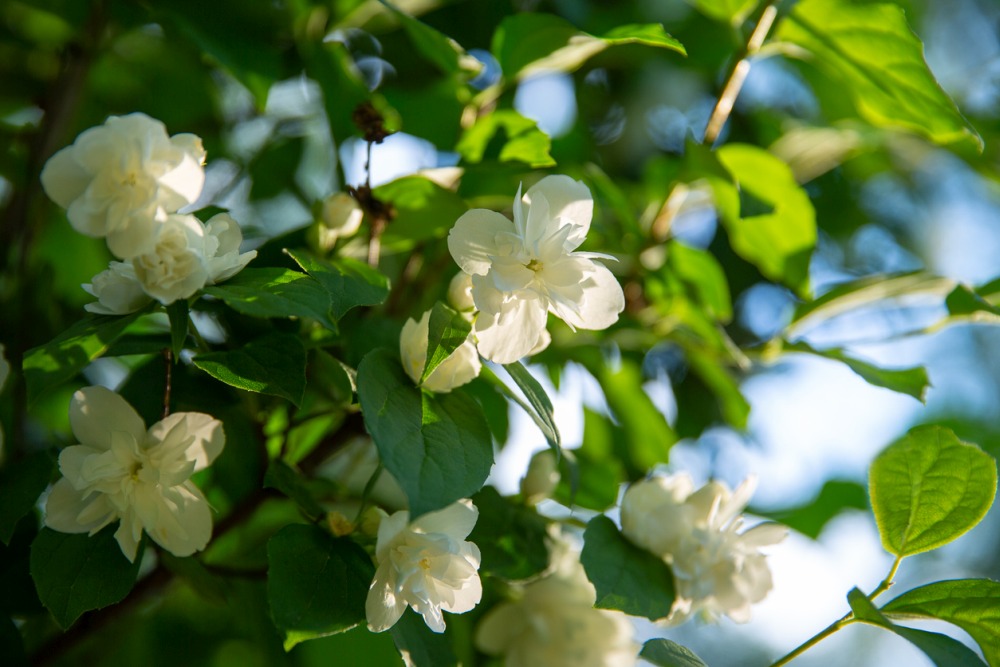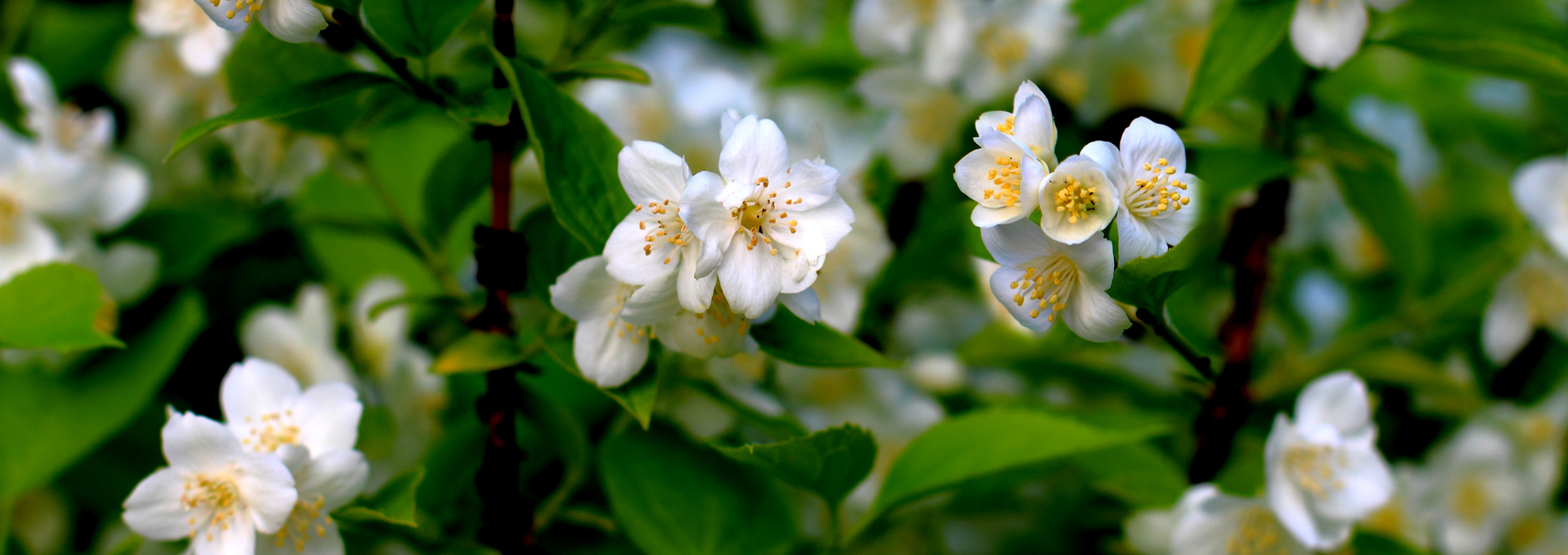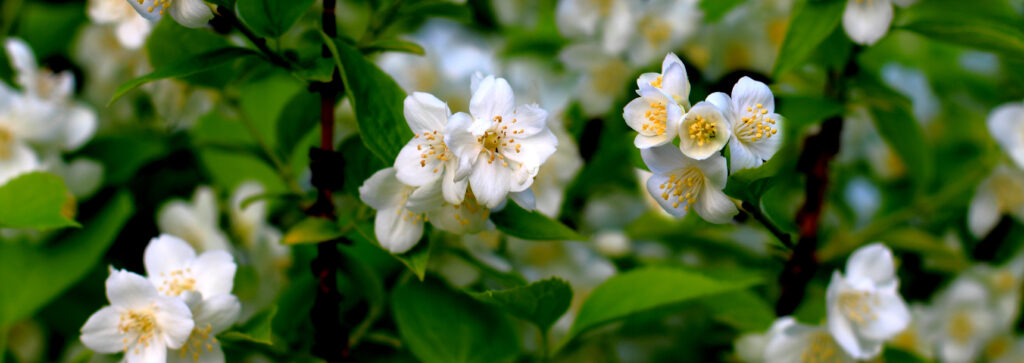Jasmine Care – How To Grow And Care For Jasmines
The exotic jasmine is a romantic plant that throws one back to an era of innocence and beauty. Even before you eyeball the delicate white flowers, their scent draws you to them a block away. And when you finally see them what a sight they make! The twining branches of this climber make their way up walls and bloom near open windows. In a way, this tropical plant adds a touch of beauty everywhere it grows. From the garden to the landscape, and even the air itself.
But the operative word here is ‘tropical’. It’s not easy to grow a tropical flowering plant if you don’t live in the tropics. You can still grow it indoors in a pot or a hanging basket, in which case you’ll have an evergreen perennial that welcomes you home with its intoxicating scent. But even if you have no prior experience with tropical plants, this guide will walk you through the necessary steps of choosing the right jasmine variety, as well as planting and caring for it.
Jasmine at a Glance
Native to the tropics of Eurasia and Oceania, jasmines are perennial flowering plants that dazzle with their foliage as well as their distinctive star-shaped flowers. The sweet scent of jasmine makes it popular in candles, cosmetics, as well as soaps. Not to mention the famous jasmine tea and essential oil.
A member of the olive family, jasmines can either be vines or shrubs. Some species are climbers, others grow upright while still some varieties cover the ground and hang over ledges and patios. The versatility of this hardy plant is stunning. Depending on the variety you grow, you could have an evergreen plant or a deciduous one that sheds its leaves in the fall.
The leaves of the plant are usually bright green and act as a backdrop to the white flowers. Each flower has between 4 to 9 petals with pink shades around the edges and is about one inch in diameter in full bloom. They grow in clusters at the end of the stems. But what the flower lacks in size, it makes up for it in fragrance. The sweet scent of the jasmine is legendary.
Jasmine Varieties
But just because a plant has ‘jasmine’ in its name doesn’t make it true jasmine. You really need to know your jasmine to make sure you have the real thing growing in your garden or hanging basket. That’s not an easy task considering that there are over 200 species of jasmine plants in the world. So here’s a rundown of the most popular true jasmines you can grow in your garden.
- White Jasmine: A native of China and Burma, this variety is a giant climber that grows up to 30 feet tall and spreads out 15 feet across. So it’s only suitable for outdoor planting as it requires a lot of space. The white flowers have a distinct and subtle scent and bloom in the late winter.
- Purple Jasmine: Another climber that reaches 20 feet tall. However, you can also train it to cover hedges, fences, and patios. The flowers are fragrant and reach about 2 inches in full bloom.
- Spanish Jasmine: This variety comes in two types, either as a vine or a shrub. It is deciduous but the main reason people grow it is the rich and deep scent. If you purchase a jasmine perfume, most likely it comes from the Spanish jasmine. The shrub reaches about 13 feet.
- Winter Jasmine: The blooms of this climber are yellow and it needs support to grow. However, it’s easy to train on a trellis or a patio. It grows to 15 feet tall but it requires a lot of pruning since it doesn’t twine like other jasmine varieties.
- Forest Jasmine: A hardy variety that has woody stems. The leaves of the plant are just as showy as the white flowers. They are dark green and reach about 3 inches on average. The stems of this climber are woody and thick. They can reach about 5 inches in diameter so consider all the pruning you have to do to keep them in shape.
How to Grow Jasmines
Growing jasmines is no walk in the park, that’s for sure. But these rewarding vines make it worth your while when they finally bloom in your garden and spread their lovely scent every which way. Here we’ll cover growing jasmine in the garden in easy steps.
- Most jasmine varieties thrive in the full sun so pick a spot facing the south or west in your garden that gets at least 8 hours of sun every day.
- Make room for the support that the vine needs to climb. Install the trellis before planting to avoid damaging the roots. If you plan to grow it as a ground cover, then you don’t need a trellis or support.
- Till the soil before planting. Use a hoe to break the topsoil and work in about 2 inches of organic compost to feed the plant and give it a good start and produce healthy fragrant blooms.
- Test the soil for drainage. Dig a hole and fill it with water. If the water disappears almost immediately, you have well-drained soil for your jasmine. If the water takes up to a minute or more to drain, then you need to mix in coarse sand or perlite to get the right texture.
- Dig a hole in the soil a few inches deeper than the rootball of the jasmine and twice as wide. Line the hole with a slow-release organic fertilizer.
- Ease the jasmine plant out of the pot it came in from the nursery. Tease the roots and spread them out. Remove any damaged or rotten roots.
- Place the plant in the hole and fill it up with soil. Pack the soil to eliminate air pockets.
- Water the plant immediately to help the soil settle.
Jasmine Care
It’s always easier and more convenient to grow a plant you bought at the nursery. But in the case of jasmines that are notorious for their low germination rate, starting them from seeds is a lengthy process that could be a hit or miss. Once you have your jasmine growing successfully in your garden, it’s time to know how to care about it and keep it blooming year after year. Both the sunlight and fertilizing are crucial for these sweet-scented blooms.
Soil
As we stated earlier, you need to ensure that your garden soil is both rich and well-drained. You might get away with planting jasmine in poor soil, but good drainage is a must. Test your soil density by filling your hand with soil and closing it tight. If the soil turns into a clump or becomes compact, you have more clay in your soil than is good for your jasmines. Mix in a good portion of coarse sand or perlite until you have the adequate soil texture. Organic and porous material will improve the drainage while also feeding the roots with their slow-release nutrients.
Light
Full sun is almost always an important part of the success of these tropical vines. As climbers, jasmines get exposed to the full sun throughout their life. So make sure to pick a spot in your garden that gets about 8 hours of sunlight every day. If you don’t get that amount of sunlight throughout the year, you could grow jasmines indoors and use sun lamps instead. The plant doesn’t tolerate cold weather well, so consider bringing it during the winter if the temperature drops below 41 degrees Fahrenheit. If your perennial fails to bloom in the spring, it might have to do with inadequate sun exposure.
Water
If the tropics are known for anything besides bright sunlight, it’s the heavy rainfall. Your jasmine will need copious amounts of water during the growing cycle. The soil should be your cue during the spring and summer. If the top couple of inches of soil dry out fast, that means you need to water the plant. When you water it, get the soil moist but don’t get it wet. How often you should water your jasmine depends on the soil texture and the weather conditions. But in general, you should strive to keep the soil moist. This perennial doesn’t tolerate drought or waterlogged soil, so strike a delicate balance between those two extremes.
Fertilizer
Jasmines are heavy feeders. Rich soil is key to their success. But sooner or later, the nutrients in the soil get depleted and you’ll need to fertilize your jasmine. Use a custom 5-10-10 fertilizer that’s low in nitrogen but high in phosphorus and potassium. Phosphorus gives you bright blooms that last longer while potassium protects the plant against infections and diseases. Apply the fertilizer once every two weeks in the spring and summer. After the last flowers have faded, stop fertilizing and start pruning.
Pruning
You’ll need to keep your pruning shears ready even before your jasmine has matured and spread its lush green foliage all over the place. When the first stems start growing, pinch the top half-inch to encourage sturdy growth. By the time the plant has reached its second year, you would have a robust vine taking the shape and design you desire. Start pruning after the last flowers have faded. Remove dead leaves, branches, and faded flowers.
Pests and Diseases
Bees and monarch butterflies are not the only insects that flock to the sweet vines of jasmine. More sinister pests attack the leaves and stems and drain out their precious sap. The most common of those are aphids, caterpillars, whiteflies, webworms, mites, and budworms. You should use neem oil to eliminate these pests without delay. If the infestation becomes widespread, consider using an organic pesticide.
Jasmine rust and blight are the two common diseases that affect this tropical plant. If the leaves show brown spots or the stems start to wilt, that could mean you have a fungal infection. This often happens after heavy rainfall. Remove the infected stems and improve air circulation around the vine. Some gardeners recommend using a baking soda spray to contain the fungal infestation.


